Mechanical and Tribological Properties of Laminated (NbTaMoW)Nx Films
Abstract
:1. Introduction
2. Materials and Methods
3. Results and Discussion
3.1. Phase Structure
3.2. Mechanical Properties
3.3. Tribological Properties
4. Conclusions
Author Contributions
Funding
Institutional Review Board Statement
Informed Consent Statement
Data Availability Statement
Acknowledgments
Conflicts of Interest
References
- Yeh, J.W.; Chen, S.K.; Lin, S.J.; Gan, J.Y.; Chin, T.S.; Shun, T.T.; Tsau, C.H.; Chang, S.Y. Nanostructured high-entropy alloys with multiple principal elements: Novel alloy design concepts and outcomes. Adv. Eng. Mater. 2004, 6, 299–303. [Google Scholar] [CrossRef]
- Cantor, B.; Chang, I.T.H.; Knight, P.; Vincent, A.J.B. Microstructural development in equiatomic multicomponent alloys. Mater. Sci. Eng. A 2004, 375–377, 213–218. [Google Scholar] [CrossRef]
- Li, W.; Liu, P.; Liaw, P.K. Microstructures and properties of high-entropy alloy films and coatings: A review. Mater. Res. Lett. 2018, 6, 199–229. [Google Scholar] [CrossRef]
- An, Z.; Jia, H.; Wu, Y.; Rack, P.D.; Patchen, A.D.; Liu, Y.; Ren, Y.; Li, N.; Liaw, P.K. Solid-solution CrCoCuFeNi high-entropy alloy thin films synthesized by sputter deposition. Mater. Res. Lett. 2015, 3, 203–209. [Google Scholar] [CrossRef]
- Feng, X.; Zhang, K.; Zheng, Y.; Zhou, H.; Wan, Z. Effect of Zr content on structure and mechanical properties of (CrTaNbMoV)Zrx high-entropy alloy films. Nucl. Instrum. Methods Phys. Res. B 2019, 457, 56–62. [Google Scholar] [CrossRef]
- Song, B.; Li, Y.; Cong, Z.; Li, Y.; Song, Z.; Chen, J. Effects of deposition temperature on the nanomechanical properties of refractory high entropy TaNbHfZr films. J. Alloys Compd. 2019, 797, 1025–1030. [Google Scholar] [CrossRef]
- Senkov, O.N.; Wilks, G.B.; Miracle, D.B.; Chuang, C.P.; Liaw, P.K. Refractory high-entropy alloys. Intermetallics 2010, 18, 1758–1765. [Google Scholar] [CrossRef]
- Zou, Y.; Maiti, S.; Steurer, W.; Spolenak, R. Size-dependent plasticity in an Nb25Mo25Ta25W25 refractory high-entropy alloy. Acta Mater. 2014, 65, 85–97. [Google Scholar] [CrossRef]
- Maiti, S.; Steurer, W. Structural-disorder and its effect on mechanical properties in single-phase TaNbHfZr high-entropy alloy. Acta Mater. 2016, 106, 87–97. [Google Scholar] [CrossRef]
- Wan, Q.; Hua, K.; Zhou, Z.; Zhang, F.; Wu, H.; Zhou, Q.; Wang, H. Revealing the B addition on tribology performance in TiZrHfTa0.5 refractory high-entropy alloy at ambient and elevated temperature. J. Alloys Compd. 2023, 931, 167521. [Google Scholar] [CrossRef]
- Chen, Y.I.; Chen, C.Y.; Chang, L.C.; Kai, W. Characterization of cosputtered NbTaMoW films. J. Mater. Res. Technol. 2021, 15, 1090–1099. [Google Scholar] [CrossRef]
- Kim, H.; Nam, S.; Roh, A.; Son, M.; Ham, M.H.; Kim, J.H.; Choi, H. Mechanical and electrical properties of NbMoTaW refractory high-entropy alloy thin films. Int. J. Refract. Met. Hard Mater. 2019, 50, 286–291. [Google Scholar] [CrossRef]
- Feng, X.; Zhang, J.; Xia, Z.; Fu, W.; Wu, K.; Liu, G.; Sun, J. Stable nanocrystalline NbMoTaW high entropy alloy thin films with excellent mechanical and electrical properties. Mater. Lett. 2018, 201, 84–87. [Google Scholar] [CrossRef]
- Song, B.; Li, Y.; Wang, K.; Cong, Z.; Gao, B.; Song, Z.; Chen, J. Nano-mechanical properties of TaNbHfZr metallic glass films. Surf. Eng. 2019, 35, 728–735. [Google Scholar] [CrossRef]
- Ou, T.Y.; Chang, L.C.; Annalakshmi, M.; Lee, J.W.; Chen, Y.I. Effects of nitrogen flow ratio on the mechanical and anticorrosive properties of cosputtered (TiZrHfTa)Nx films. Surf. Coat. Technol. 2024, 477, 130410. [Google Scholar] [CrossRef]
- Lee, J.W.; Chen, C.Y.; Chen, Y.J.; Tzeng, C.H.; Chen, Y.I. Effects of nitrogen flow ratio on the structural, mechanical, and anticorrosive properties of co-sputtered (NbTaMoW)Nx films. J. Mater. Res. Technol. 2022, 21, 1890–1902. [Google Scholar] [CrossRef]
- Shu, R.; Paschalidou, E.M.; Rao, S.G.; Lu, J.; Greczynski, G.; Lewin, E.; Nyholm, L.; le Febvrier, A.; Eklund, P. Microstructure and mechanical, electrical, and electrochemical properties of sputter-deposited multicomponent (TiNbZrTa)Nx coatings. Surf. Coat. Technol. 2020, 389, 125651. [Google Scholar] [CrossRef]
- Bachani, S.K.; Wang, C.J.; Lou, B.S.; Chang, L.C.; Lee, J.W. Fabrication of TiZrNbTaFeN high-entropy alloys coatings by HiPIMS: Effect of nitrogen flow rate on the microstructural development, mechanical and tribological performance, electrical properties and corrosion characteristics. J. Alloys Compd. 2021, 873, 159605. [Google Scholar] [CrossRef]
- Lewin, E. Multi-component and high-entropy nitride coatings—A promising field in need of a novel approach. J. Appl. Phys. 2020, 127, 160901. [Google Scholar] [CrossRef]
- Chang, S.Y.; Huang, Y.C.; Li, C.E.; Hsu, H.F.; Yeh, J.W.; Lin, S.J. Improved diffusion-resistant ability of multicomponent nitrides: From unitary TiN to senary high-entropy (TiTaCrZrAlRu)N. JOM 2013, 65, 1790–1796. [Google Scholar] [CrossRef]
- Pogrebnjak, A.D.; Yakushchenko, I.V.; Bagdasaryan, A.A.; Bondar, O.V.; Krause-Rehberg, R.; Abadias, G.; Chartier, P.; Oyoshi, K.; Takeda, Y.; Beresnev, V.M.; et al. Microstructure, physical and chemical properties of nanostructured (Ti–Hf–Zr–V–Nb)N coatings under different deposition conditions. Mater. Chem. Phys. 2014, 147, 1079–1091. [Google Scholar] [CrossRef]
- Chiu, H.S.; Ou, T.Z.; Chen, Y.I. Effects of thickness ratio on phase structures, mechanical properties, and wear behaviors of CrN/ZrB2 bilayer films. Surf. Coat. Technol. 2024, 481, 130694. [Google Scholar] [CrossRef]
- Wang, Y.X.; Zhang, S. Toward hard yet tough ceramic coatings. Surf. Coat. Technol. 2014, 258, 1–16. [Google Scholar] [CrossRef]
- Hsu, S.Y.; Chi, C.C.; Lu, M.Y.; Chang, S.Y.; Lai, Y.T.; Tsai, S.Y.; Duh, J.G. Hard yet tough thermodynamics-drive nanostructured (AlCrNbSixTi)N multicomponent nitride hard coating. J. Alloys Compd. 2023, 947, 169645. [Google Scholar] [CrossRef]
- Chen, Y.I.; Lu, T.S. Internal oxidation of laminated ternary Ru–Ta–Zr coatings. Appl. Surf. Sci. 2015, 353, 245–253. [Google Scholar] [CrossRef]
- Chen, Y.I.; Lu, T.S.; Zheng, Z.T. Internally oxidized Ru–Zr multilayer coatings. Coatings 2017, 7, 46. [Google Scholar] [CrossRef]
- Chang, L.C.; Wang, L.Z.; Chen, Y.I. The effects of nitrogen content on the mechanical and tribological properties of CrTaWNx thin films. Coatings 2024, 14, 939. [Google Scholar] [CrossRef]
- Oliver, W.C.; Pharr, G.M. An improved technique for determining hardness and elastic modulus using load and displacement sensing indentation experiments. J. Mater. Res. 1992, 7, 1564–1583. [Google Scholar] [CrossRef]
- Janssen, G.C.A.M.; Abdalla, M.M.; van Keulen, F.; Pujada, B.R.; van Venrooy, B. Celebrating the 100th anniversary of the Stoney equation for film stress: Developments from polycrystalline steel strips to single crystal silicon wafers. Thin Solid Film. 2009, 517, 1858–1867. [Google Scholar] [CrossRef]
- Brantly, W.A. Calculated elastic constants for stress problems associated with semiconductor devices. J. Appl. Phys. 1973, 44, 534–535. [Google Scholar] [CrossRef]
- Yuan, Y.; Wu, Y.; Yang, Z.; Liang, X.; Lei, Z.; Huang, H.; Wang, H.; Liu, X.; An, K.; Wu, W.; et al. Formation, structure and properties of biocompatible TiZrHfNbTa high-entropy alloys. Mater. Res. Lett. 2019, 7, 225–231. [Google Scholar] [CrossRef]
- Guo, S.; Ng, C.; Lu, J.; Liu, C.T. Effect of valence electron concentration on stability of fcc or bcc phase in high entropy alloys. J. Appl. Phys. 2011, 109, 103505. [Google Scholar] [CrossRef]
- Stasiak, T.; Souček, P.; Buršíková, V.; Koutná, N.; Czigány, Z.; Balázsi, K.; Vašina, P. Synthesis and characterization of the ceramic refractory metal high entropy nitride thin films from Cr-Hf-Mo-Ta-W system. Surf. Coat. Technol. 2022, 449, 128987. [Google Scholar] [CrossRef]
- von Fieandt, K.; Pilloud, D.; Fritze, S.; Osinger, B.; Pierson, J.F.; Lewin, R. Optical and electrical properties of hard (Hf,Nb,Ti,V,Zr)Nx thin films. Vacuum 2021, 193, 110517. [Google Scholar] [CrossRef]
- Lou, B.S.; Annalakshmi, M.; Su, Y.W.; Yang, W.S.; Lee, J.W. Fabrication of TiN coatings using superimposed HiPIMS and MF technique: Effect of target poisoning ratios and MF/HiPIMS pulse on-time ratio. Surf. Coat. Technol. 2024, 478, 130364. [Google Scholar] [CrossRef]
- Das, S.; Guha, S.; Ghadai, R.; Swain, B.P. A comparative analysis over different properties of TiN, TiAlN and TiAlSiN thin film coatings grown in nitrogen gas atmosphere. Mater. Chem. Phys. 2021, 258, 123866. [Google Scholar] [CrossRef]
- Xia, A.; Dedoncker, R.; Glushko, O.; Cordill, M.J.; Depla, D.; Franz, R. Influence of the nitrogen content on the structure and properties of MoNbTaVW high entropy alloy thin films. J. Alloys Compd. 2021, 850, 156740. [Google Scholar] [CrossRef]
- Li, H.; Jiang, N.; Li, J.; Huang, J.; Kong, J.; Xiong, D. Hard and tough (NbTaMoW)Nx high entropy nitride films with substoichiometric nitrogen. J. Alloys Compd. 2021, 889, 161713. [Google Scholar] [CrossRef]
- Lou, B.S.; Wang, C.J.; Chen, Y.Y.; Hung, S.B.; Lin, Y.C.; Lee, J.W. Phase, mechanical property and corrosion resistance evaluation of W-Nb-Ta-Ti and W-Nb-Ta-Ti-N medium entropy alloy thin films. Surf. Coat. Technol. 2022, 442, 128339. [Google Scholar] [CrossRef]
- Kao, W.H.; Su, Y.L.; Lin, Y.J. Mechanical, tribological, and anti-corrosion properties of nitrogen-doped AlCrNbSiTiMoW high-entropy coatings. J. Mater. Eng. Perform. 2024, 33, 6092–6110. [Google Scholar] [CrossRef]
- Fox-Rabinovich, G.S.; Yamamoto, K.; Veldhuis, S.C.; Kovalev, A.I.; Shuster, L.S.; Ning, L. Self-adaptive wear behavior of nanomultilayered TiAlCrN/WN coatings under severe machining conditions. Surf. Coat. Technol. 2006, 201, 1852–1860. [Google Scholar] [CrossRef]
- Pogrebnjak, A.D.; Beresnev, V.M.; Bondar, O.V.; Postolnyi, B.O.; Zaleski, K.; Coy, E.; Jurga, S.; Lisovenko, M.O.; Konarski, P.; Rebouta, L.; et al. Superhard CrN/MoN coatings with multilayer architecture. Mater. Des. 2018, 153, 47–59. [Google Scholar] [CrossRef]
- Tsui, T.Y.; Pharr, G.M.; Oliver, W.C.; Bhatia, C.S.; White, R.L.; Anders, S.; Anders, A.; Brown, I.G. Nanoindentation and nanoscratching of hard carbon coatings for magnetic disks. Mater. Res. Soc. Symp. Proc. 1995, 383, 447–452. [Google Scholar] [CrossRef]
- Leyland, A.; Matthews, A. On the significance of the H/E ratio in wear control: A nanocomposite coating approach to optimised tribological behavior. Wear 2000, 246, 1–11. [Google Scholar] [CrossRef]
- Pogrebnjak, A.; Smyrnova, K.; Bondar, O. Nanocomposite multilayer binary nitride coatings based on transition and refractory metals: Structure and properties. Coatings 2019, 9, 155. [Google Scholar] [CrossRef]
- Tian, C.; Xiang, Y.; Zou, C.; Yu, Y.; Abudouwufu, T.; Yang, B.; Fu, D. Mechanical and tribological properties of CrWN/MoN nano-multilayer coatings deposited by cathodic arc ion plating. Coatings 2024, 14, 367. [Google Scholar] [CrossRef]
- Shugurov, A.R.; Kazachenok, M.S. Mechanical properties and tribological behavior of magnetron sputtered TiAlN/TiAl multilayer coatings. Surf. Coat. Technol. 2018, 353, 254–262. [Google Scholar] [CrossRef]
- Zhang, K.; Wen, M.; Meng, Q.N.; Zeng, Y.; Hu, C.Q.; Liu, C.; Zheng, W.T. Structure, mechanical property, and tribological behavior of c-NbN/CNx multilayers grown by magnetron sputtering. Surf. Coat. Technol. 2012, 206, 4040–4045. [Google Scholar] [CrossRef]
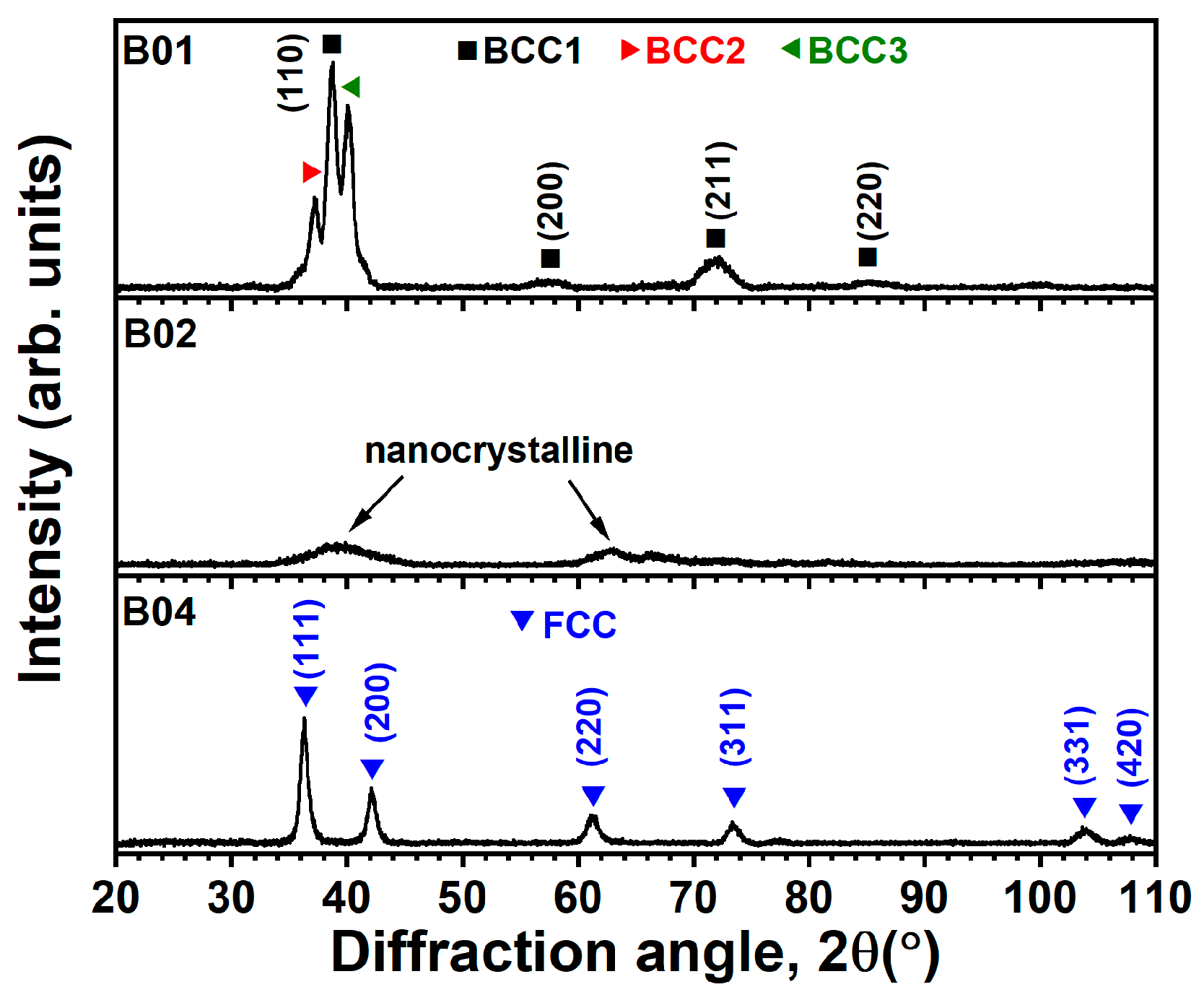
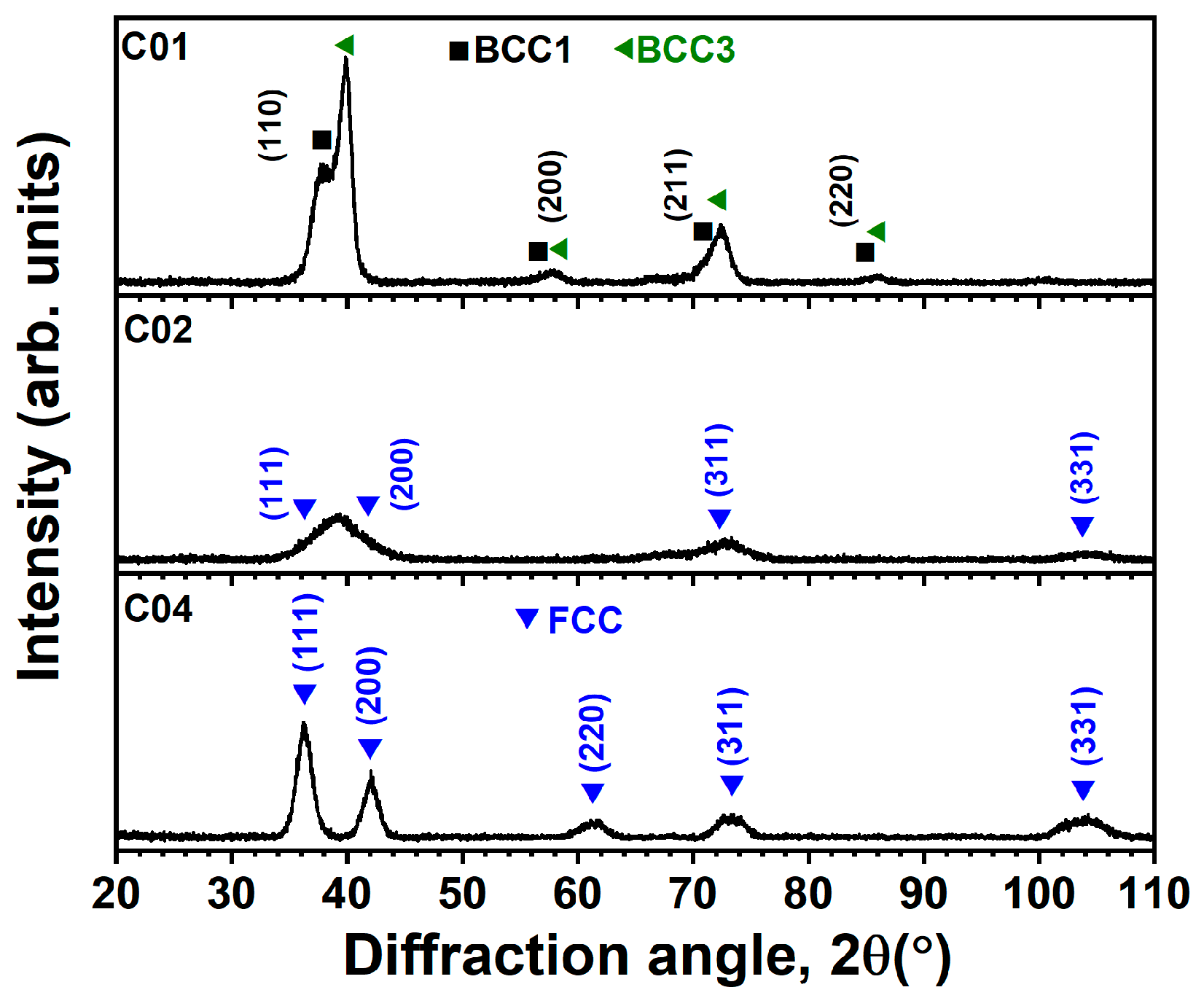
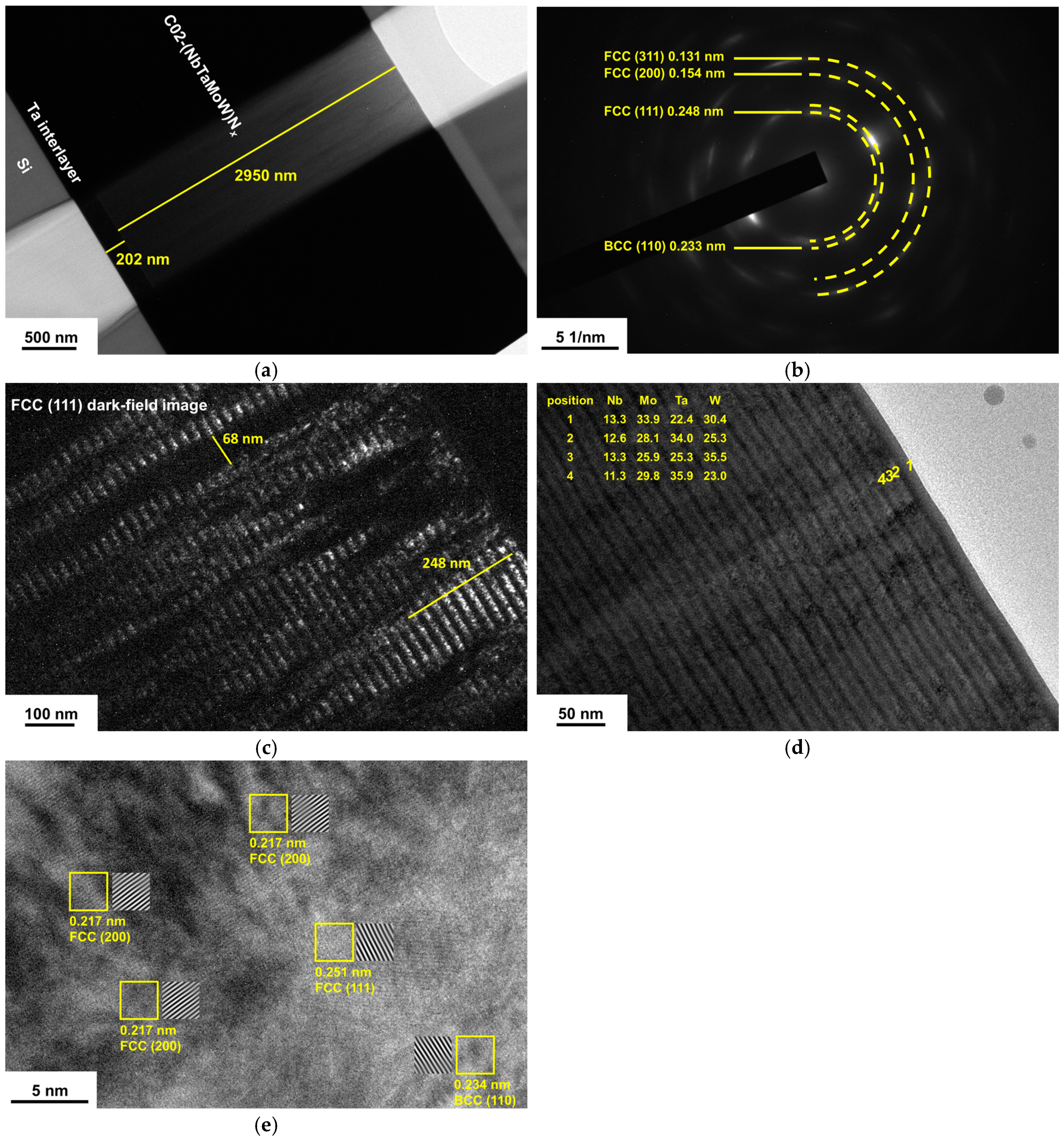

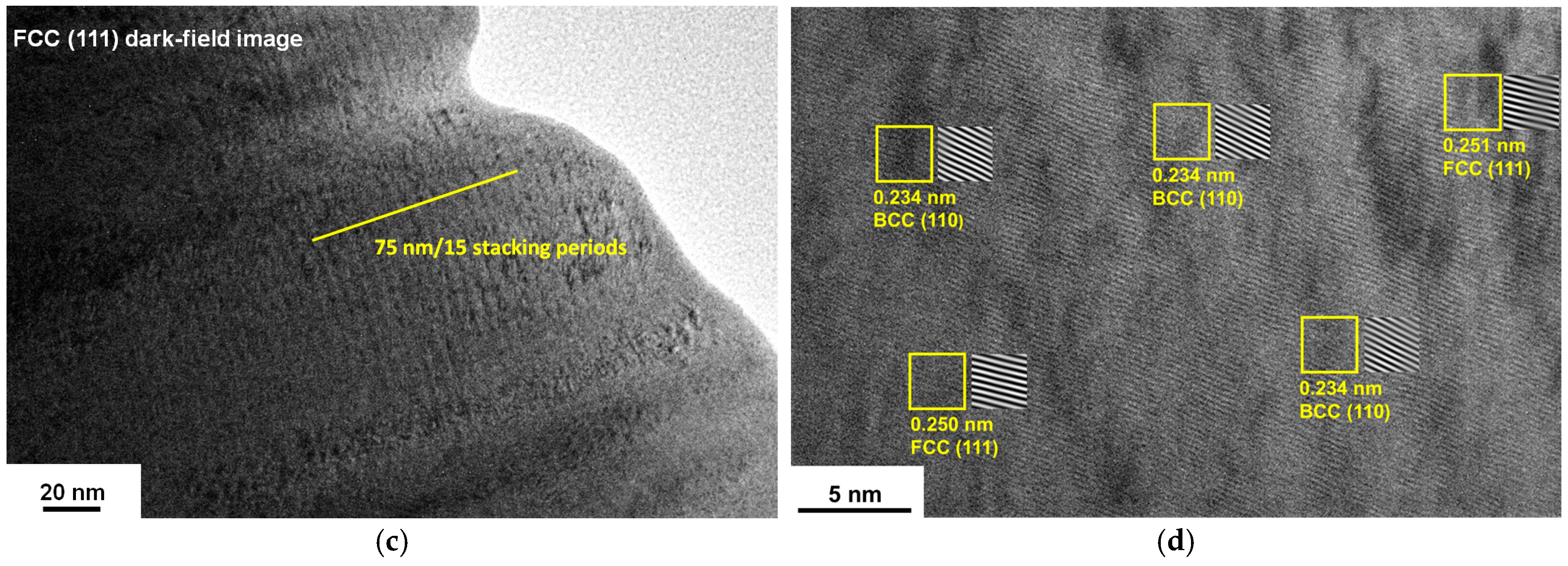
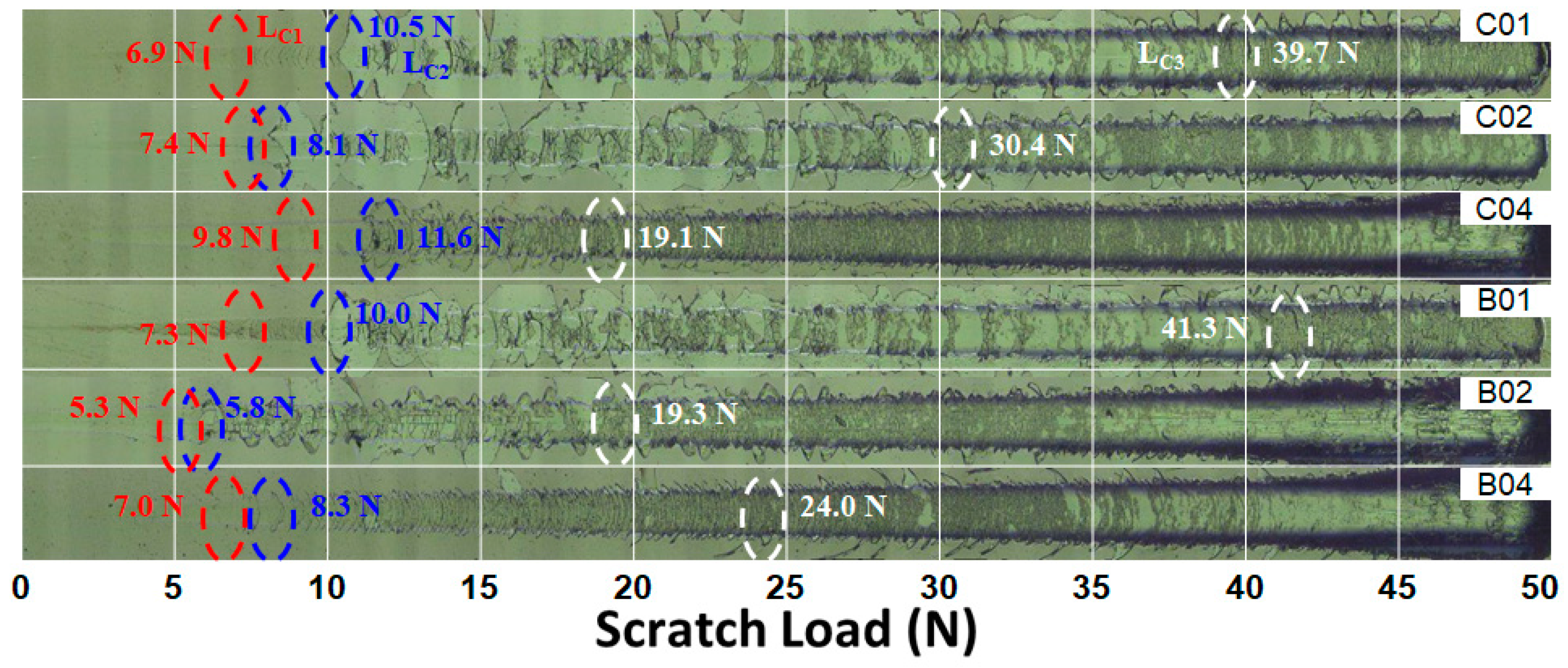

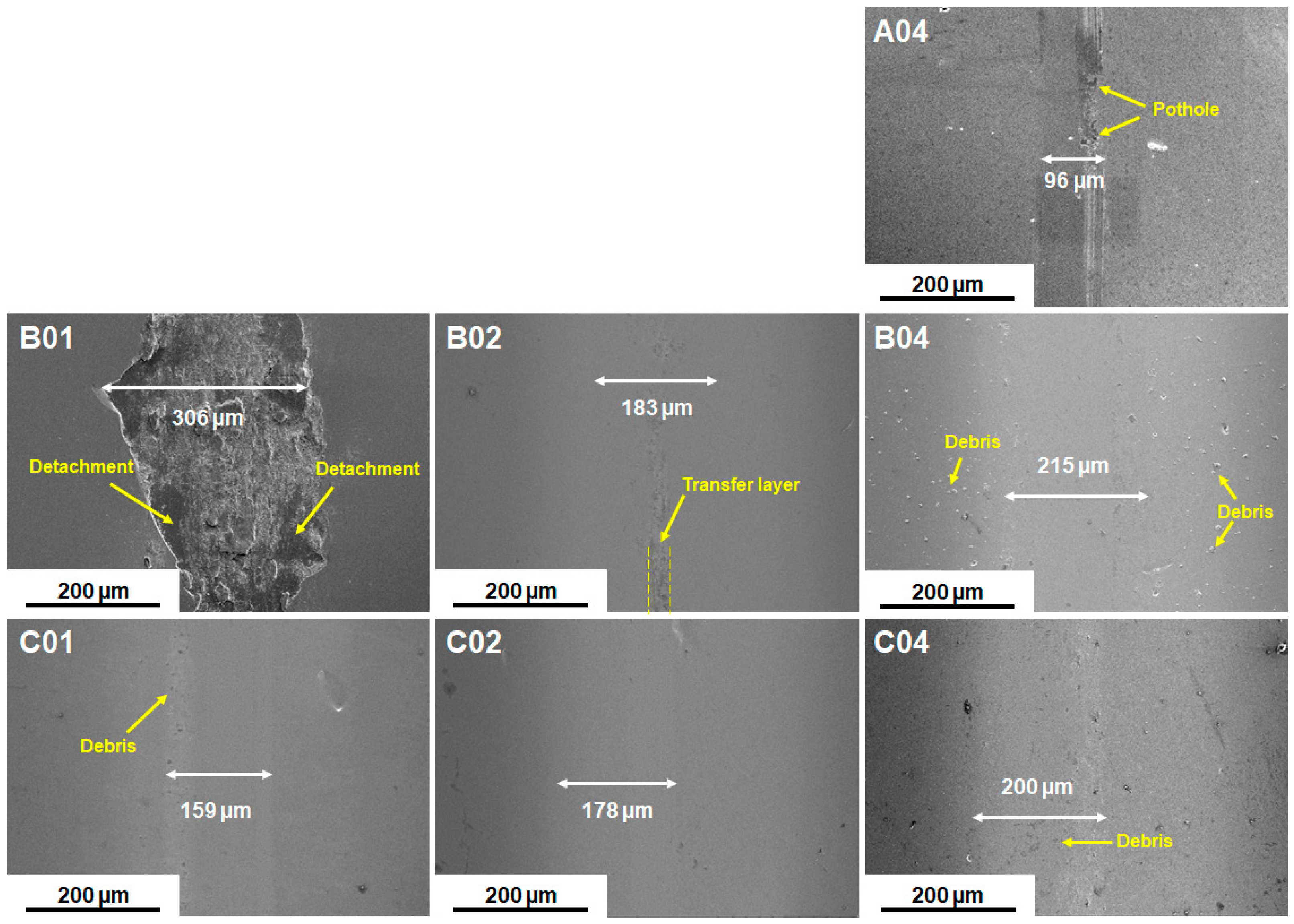
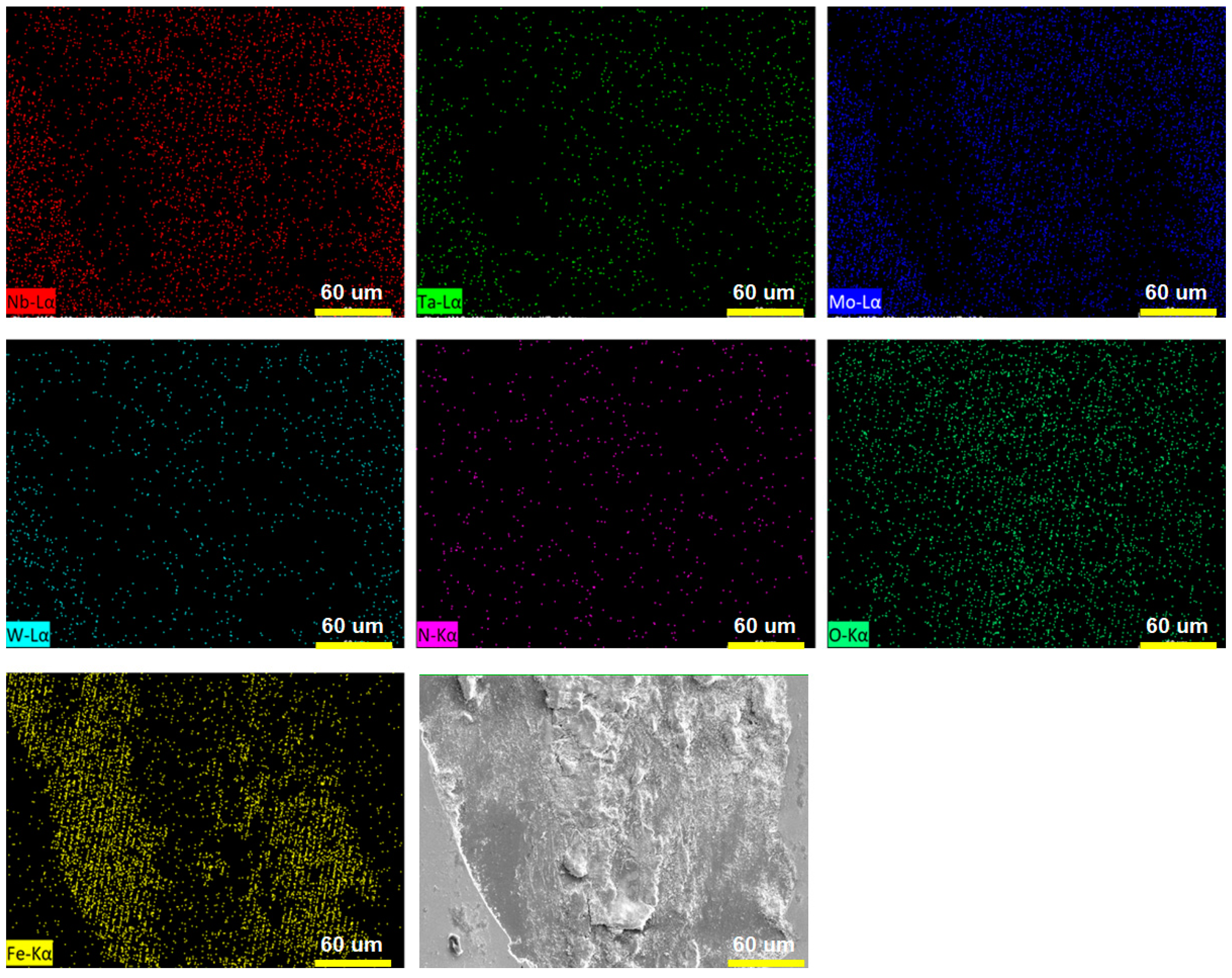
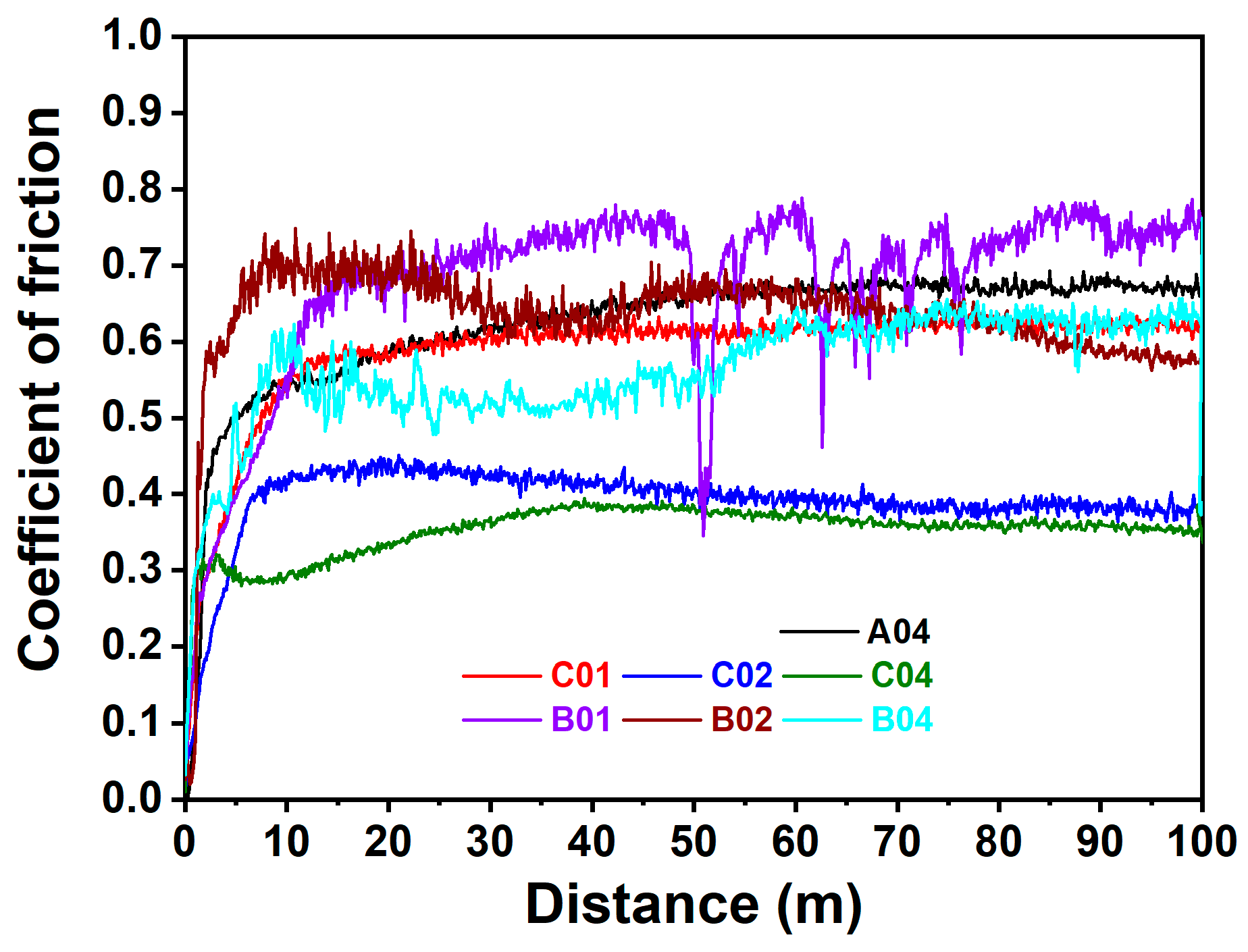
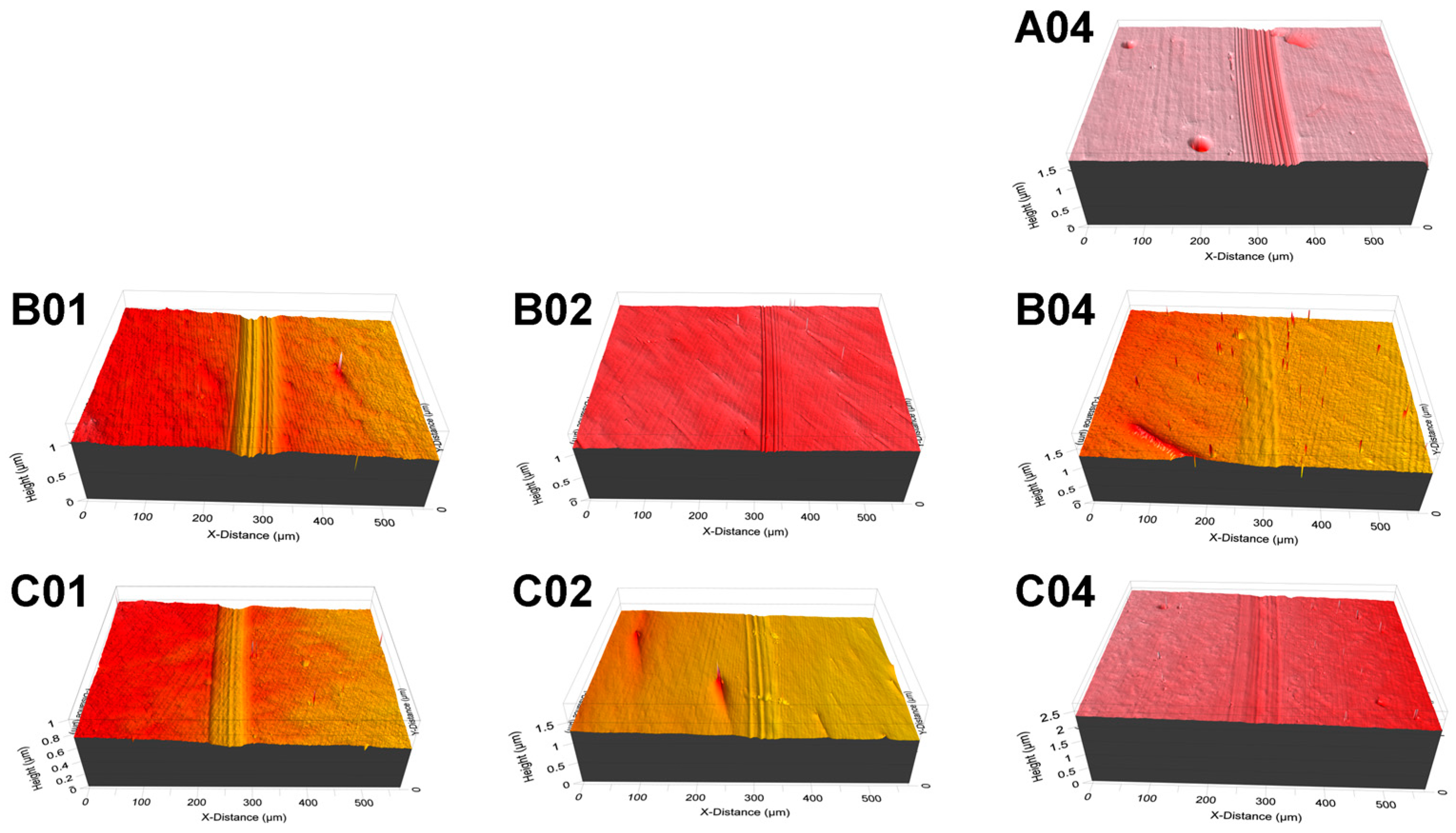
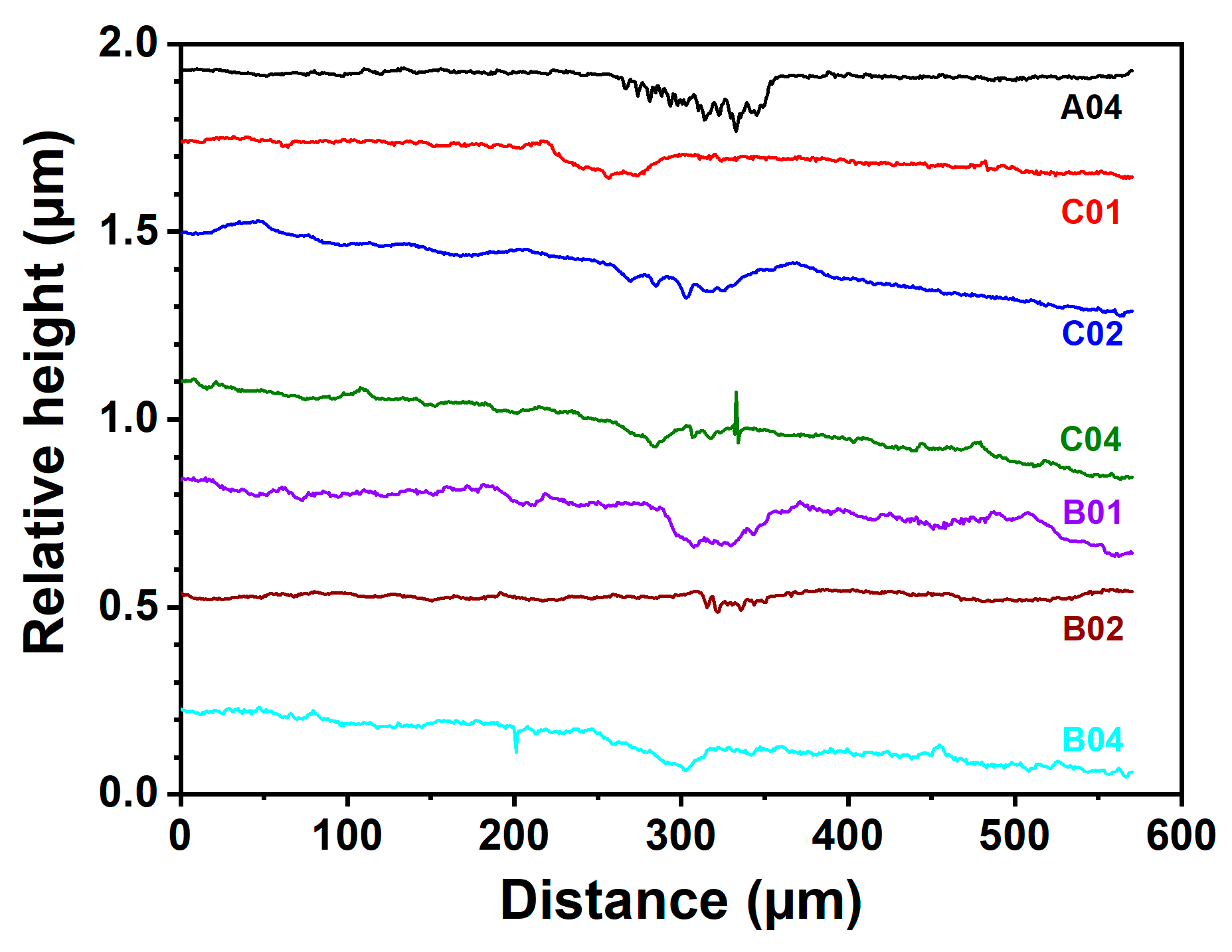
| Sample | RH 1 (rpm) | fN2 2 |
|---|---|---|
| A01 | 30 | 0.1 |
| A02 | 30 | 0.2 |
| A04 | 30 | 0.4 |
| B01 | 10 | 0.1 |
| B02 | 10 | 0.2 |
| B04 | 10 | 0.4 |
| C01 | 2 | 0.1 |
| C02 | 2 | 0.2 |
| C03 | 2 | 0.4 |
| Sample | H a (GPa) | E b (GPa) | H/E | H3/E2 (GPa) | We c (%) | Residual Stress (GPa) |
|---|---|---|---|---|---|---|
| A01 | 24.7 ± 1.3 | 351 ± 14 | 0.070 | 0.122 | – | –0.17 ± 0.00 |
| A02 | 29.3 ± 1.4 | 333 ± 12 | 0.088 | 0.227 | – | –0.04 ± 0.01 |
| A04 | 29.9 ± 0.9 | 343 ± 8 | 0.087 | 0.227 | – | –1.14 ± 0.19 |
| B01 | 21.6 ± 0.5 | 325 ± 6 | 0.066 | 0.095 | 55 | –0.04 ± 0.10 |
| B02 | 23.0 ± 0.5 | 337 ± 9 | 0.068 | 0.107 | 57 | –0.18 ± 0.04 |
| B04 | 26.1 ± 0.7 | 377 ± 16 | 0.069 | 0.125 | 60 | –0.91 ± 0.06 |
| C01 | 19.3 ± 0.9 | 317 ± 13 | 0.061 | 0.071 | 53 | –0.25 ± 0.09 |
| C02 | 23.4 ± 0.4 | 337 ± 6 | 0.069 | 0.113 | 58 | –0.61 ± 0.21 |
| C04 | 25.2 ± 1.6 | 386 ± 23 | 0.065 | 0.107 | 57 | –0.80 ± 0.28 |
| Sample | Thickness (nm) | Wear Depth (nm) | COF a | Wear Rate (mm3/Nm) |
|---|---|---|---|---|
| A04 | 1947 | 86 | 0.66 | 1.02 × 10−6 |
| B01 | 3400 | 110 b | 0.72 | – |
| B02 | 2990 | 55 | 0.63 | 7.67 × 10−7 |
| B04 | 2440 | 73 | 0.59 | 8.27 × 10−7 |
| C01 | 3520 | 50 | 0.62 | 6.18 × 10−7 |
| C02 | 2950 | 46 | 0.39 | 5.70 × 10−7 |
| C04 | 2300 | 83 | 0.37 | 3.16 × 10−7 |
Disclaimer/Publisher’s Note: The statements, opinions and data contained in all publications are solely those of the individual author(s) and contributor(s) and not of MDPI and/or the editor(s). MDPI and/or the editor(s) disclaim responsibility for any injury to people or property resulting from any ideas, methods, instructions or products referred to in the content. |
© 2024 by the authors. Licensee MDPI, Basel, Switzerland. This article is an open access article distributed under the terms and conditions of the Creative Commons Attribution (CC BY) license (https://creativecommons.org/licenses/by/4.0/).
Share and Cite
Liao, Y.-Z.; Chen, Y.-I. Mechanical and Tribological Properties of Laminated (NbTaMoW)Nx Films. Materials 2024, 17, 4962. https://doi.org/10.3390/ma17204962
Liao Y-Z, Chen Y-I. Mechanical and Tribological Properties of Laminated (NbTaMoW)Nx Films. Materials. 2024; 17(20):4962. https://doi.org/10.3390/ma17204962
Chicago/Turabian StyleLiao, Yan-Zhi, and Yung-I Chen. 2024. "Mechanical and Tribological Properties of Laminated (NbTaMoW)Nx Films" Materials 17, no. 20: 4962. https://doi.org/10.3390/ma17204962






